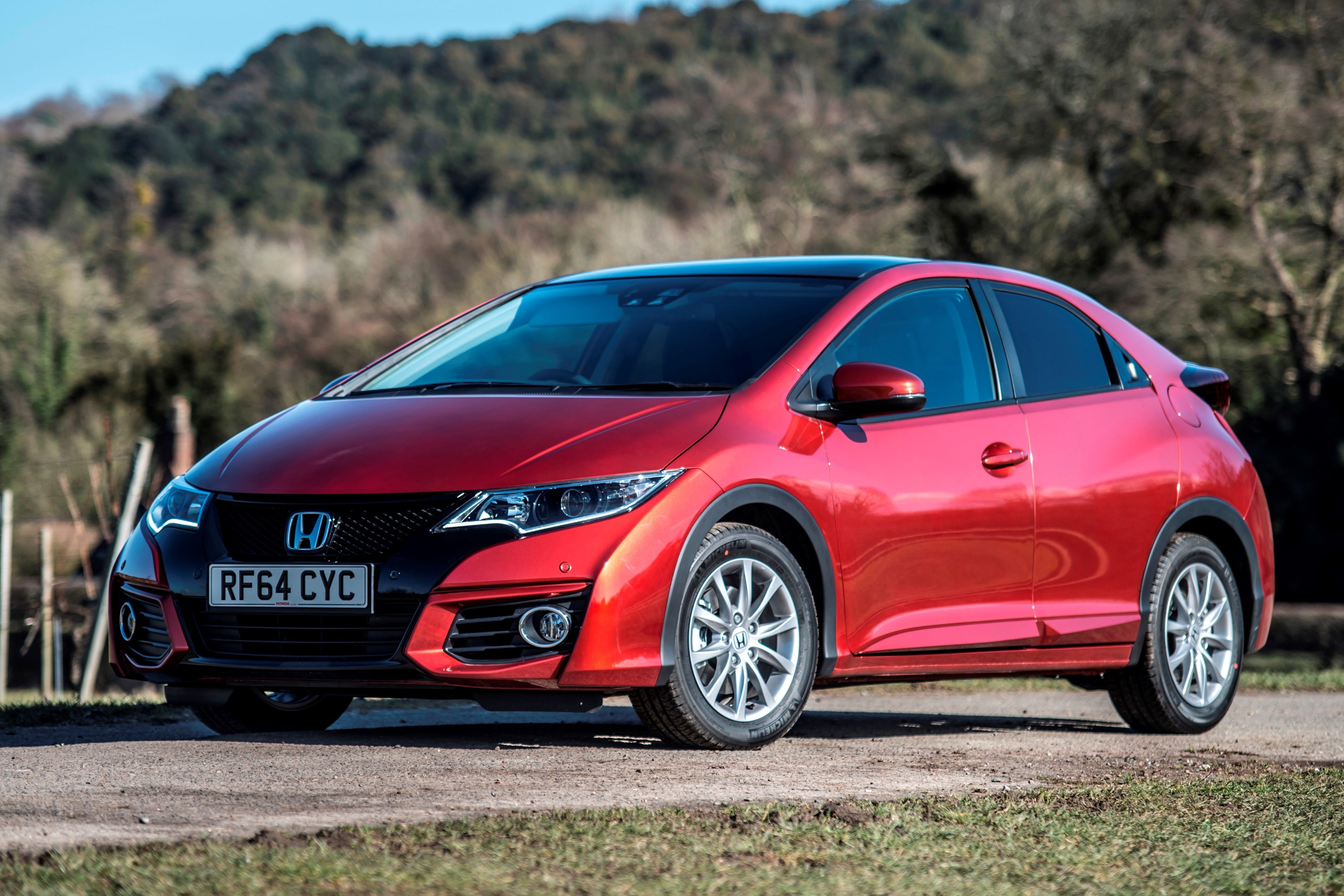Honda Civic (2017-2021) Review
Written by Andrew Brady
Quick overview
Pros
- Practicality among best in class
- Famed Honda reliability
- Stand-out styling
Cons
- Not as fun to drive as the previous one
- Petrol engines lack pulling power
- Cheap interior
Overall verdict on the Honda Civic
"In this Honda Civic review we are taking a look at a sometimes forgotten contender in the hotly-contested compact hatchback segment. It has a number of strengths - it's very practical, well-built and reliable, is cheap to run and is well-equipped, which makes it an appealing option on many levels. On the downside it's not huge fun to drive and doesn't have the premium feel that some rivals do, but if those things don't matter so much it makes for a smart secondhand buy."
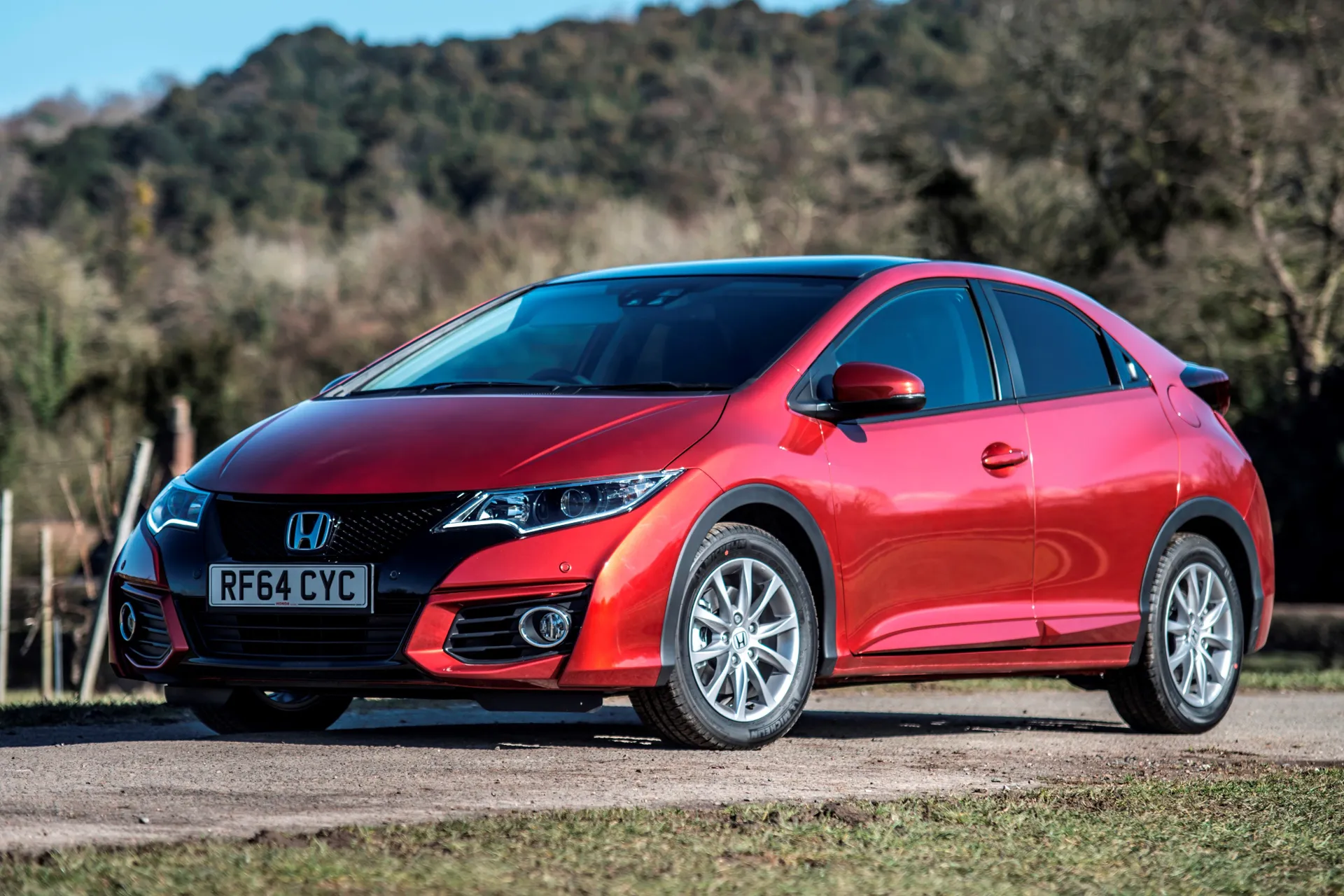
"The Honda Civic has been around in one form or another since the 1970s. In that time, it’s grown from being a Mini rival into a full-sized family hatchback that takes on another sector stalwart: the Volkswagen Golf. With this ninth-generation model, Honda took a leaf out of the Volkswagen design book, going for evolution – rather than revolution.
This was unusual for Honda, which normally likes to start with a blank sheet of paper. However, the previous Civic to this one had been a real hit, with customers really warming to its angular, edgy styling. Honda reckoned refining this approach would work for the new model, just as every new Golf is really just an improved version of the previous one.
Visually, then, it still looked unlike anything else in its sector. The beak-like nose was short and sharp, the long wheelbase gave it a squat stance and there was loads of drama at the rear, from the ‘floating’ full-width lights, to the split hatchback with its extra window, to the newly-emboldened rear haunches. Even the rear door handles were hidden. Facelifted cars from 2015 onwards were smarter still, using distinctive LED running lights in the headlights.
The interior was also exciting. Again, it drew from the spacecraft-style layout of the previous model, but materials were better – if still cheap compared to a Golf – and the control layout more modern. Even today, it remains an extremely practical car, with a tremendous amount of rear-seat space and a big boot. Honda fits the fuel tank under the front seats, rather than beneath the boot floor, and this frees up a lot of space to enhance practicality.
It’s a simple engine line-up: 1.4-litre and 1.8 petrols, plus a 2.2 diesel. This later shrunk into a 1.6 diesel, but it still had decent pulling power, so didn’t feel too much like a step back. There was also a new Civic Type R model, which we’ve tested separately, with a thrilling 2.0-litre VTEC turbo petrol engine. It’s a riotous thrill-ride and fast becoming a cult classic.
Regular Civics are, however, a bit less exciting. Some of the edge of the previous Civic was lost in the redesign, meaning it’s less chuckable and engaging. On the flip-side, a big criticism of the old Civic, its poor ride quality, was now improved, making this generation of Civic a better all-rounder.
Honda is generous with the standard equipment, particularly on higher-spec versions. There’s a good haul of electronic gadgets and, on many cars, a comprehensive-looking infotainment system. Sadly, it’s not quite as good to use as it is to look at.
Perhaps the most compelling reason to check out the Civic today is Honda’s famed reliability. This is an almost bomb-proof car that will run and run. It will shrug off high mileages and stand up to hard work without complaint. With prices now becoming temptingly affordable for what’s still a modern-looking car, there’s plenty to like here. Even if it won’t thrill in quite the same way some Civics have done in the past.
If you're looking for the newer version, you need our 2017-2021 Honda Civic review.
Is the Honda Civic right for you?
Two big reasons to buy a Honda Civic: practicality and reliability. The latter is a well-deserved reputation that’s entirely down to Honda’s meticulous engineering standards (and loyal customers regularly returning to the friendly dealer network for routine servicing).
Practicality is where it really stands out alongside the competition. The layout of the oily bits beneath is that bit more creative than many rivals, so Honda’s been able to free up extra space for passengers and luggage. If you’re more familiar with a Ford Focus or Vauxhall Astra, you’ll find the Civic Tardis-like.
Honda offers a wide range of trims, so there are lots of model grades to choose from. Engine choice is more limited, and only the 1.8-litre petrol is available with an automatic gearbox. But all engines are robust and powerful for their size – Honda is particularly famed for its engines, after all – meaning it’s only the lack of turbo-style pulling power at low revs from petrol versions that is likely to cause complaint.
What’s the best Honda Civic model/engine to choose?
The 1.4 is a nice engine, but it’s too small for a car this size. If you drive fully-laden, it will feel very lethargic. The 1.8 is better, with more of the famous VTEC growl at high revs. But you do have to rev it more than, say, a Focus Ecoboost petrol.
So we’d stick with the diesels, which sold well when the Honda Civic was new. The older 2.2-litre is uncommonly smooth and a pleasure to use. But the 1.6-litre, which is not quite as watch-like, is better on emissions and economy, delivering eye-widening MPG in its most economical form.
As for trims, we like our Honda Civics with lots of goodies, so would go for EX, SE Plus, or the later and cool-looking Sport grade.
What other cars are similar to the Honda Civic?
The family hatchback sector is packed with alternatives, such as the aforementioned Volkswagen Golf, Ford Focus and Vauxhall Astra. From South Korea, there’s the Hyundai i30 and Kia Ceed. And from France, the Peugeot 308 and Renault Megane.
Japanese challengers include the Mazda 3 and Toyota Auris (and the now well-forgotten Nissan Pulsar). The Skoda Octavia also provides a stern challenge to the Civic in terms of sheer space and practicality
Comfort and design: Honda Civic interior
"The bold, angular styling of the Honda Civic continues as you step within - watch your right knee on that protruding bit of the dashboard, though – whacking it is painful. The layout is split into two, with a crescent-shaped upper panel containing the stereo screen and speedo, and three round instruments mounted in a binnacle below."
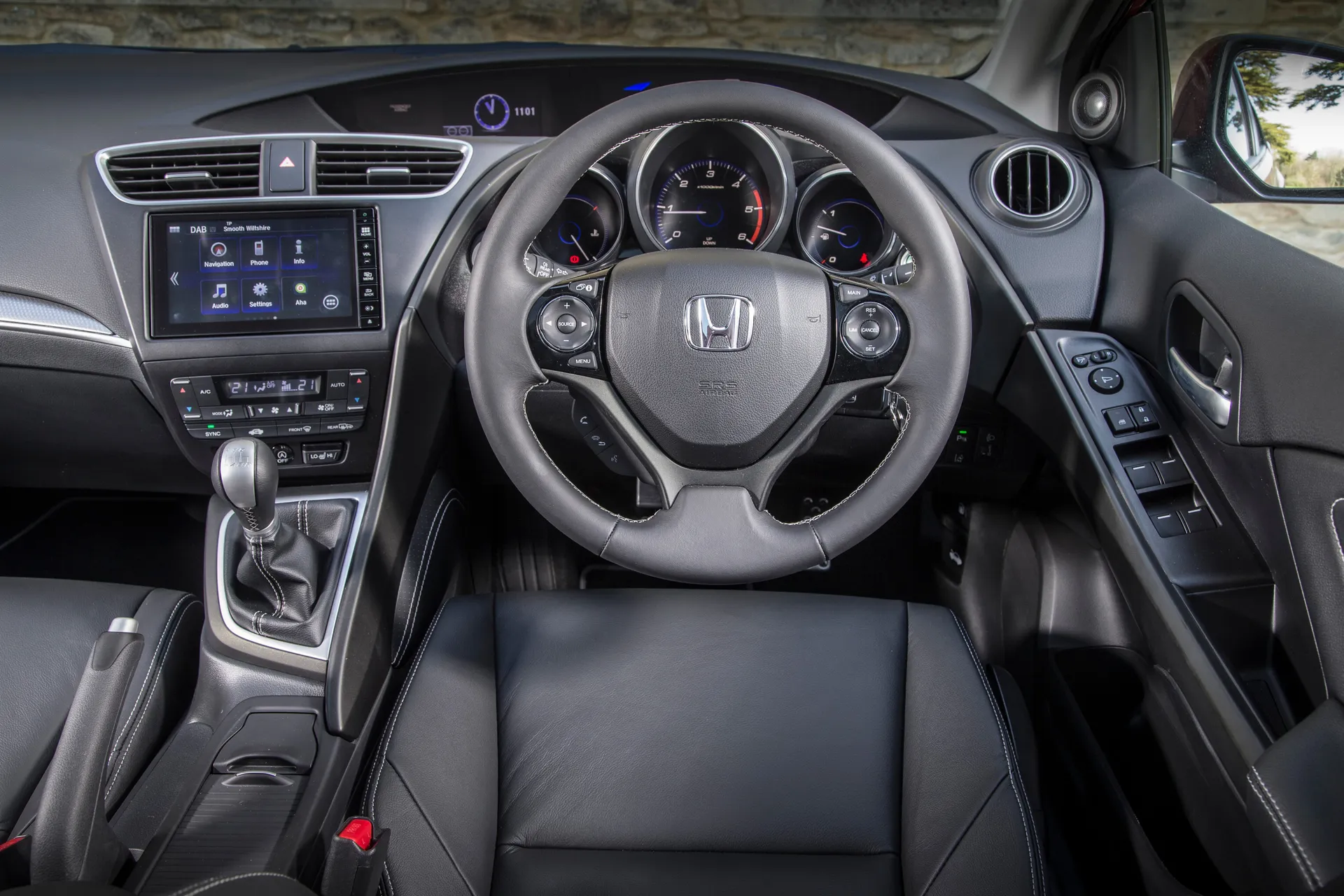
There’s a second screen on the centre console for the infotainment – or a conventional row of buttons on more basic models. It’s a drama-packed design, contrasting with the simplicity of a Golf. A mix of materials and trims makes it yet livelier – you sense the designers got so carried away making it look exciting that they forgot to leave somewhere to put the climate controls. They’re tucked up below the infotainment screen, with the gear lever half in the way.
With so much going on, it’s a design that takes time to become familiar with. Having the speedo split so far away from the rest of the dials is unusual, for example. At least the fundamentals are in the right place, from a conveniently-located manual handbrake to a perfectly-positioned gear lever. And even though it’s mounted a bit low down on the dash, it’s easy to reach the central infotainment touchscreen.
Seat comfort is OK, but nothing to write home about. The best chairs are in the Type R, with seats in the Sport also a bit better than standard. Because the fuel tank is located below, some might find them just a touch too high, and the unusual layout of the dashboard also makes it trickier to find a driving position that works. You’ll be cursing the person who moves your seat…
Quality and finish
Honda assembles its cars exceedingly well. The Honda Civic is a precision-built machine, with ultra-tight build quality and a sense of real manufacturing accuracy. It’s because of this that its cars last so long and prove so robust even after years of heavy-duty use. This Civic does nothing to spoil that reputation.
Material quality, however, is another matter. It’s all nicely screwed together, but the materials themselves aren’t as soft-touch and rich as you get in some rivals. Dare we say, if you’re coming from a Golf, you might find the Civic a bit cheap-feeling.
There are just a few too many hard, thin plastics, while the seat seems cheaply-trimmed and a bit sparse-looking. Tap certain areas and you’ll hear a hollow rattle rather than the muffled thunk you get in a Golf.
Even the paint quality isn’t as deep as some alternatives. Again, it’s beautifully assembled, with tight panel gaps… but it doesn’t quite have the depth of shine you’ll find on the teacher’s pet Volkswagen Golf.
Infotainment: Touchscreen, USB, nav and stereo in the Honda Civic
Honda badly lags behind the best in terms of infotainment. All cars come with the Honda I-MID information display, but this is basically a glorified trip computer that feeds into a fuzzy-looking screen at the base of the windscreen. It is nothing to get excited about.
Models without sat-nav have a conventional stereo, with actual buttons and knobs, which is controlled via a menu in the I-MID screen. It all feels rather old-fashioned.
Pick a Honda Civic with sat-nav and the radio display becomes a colour touchscreen. It looks a bit aftermarket and is a standalone system, rather than being nicely integrated into the Civic’s other screens and displays. It is also fiddly to use, doesn’t react very quickly and has very dated graphics.
Honda Connect, which was introduced from 2015, is an improvement, but still not great. It’s based on an Android operating system, so includes smartphone-style pinch and swipe functionality, although even this set-up feels a bit old-fashioned today.
Space and practicality: Honda Civic boot space
Space and practicality are something the Honda Civic excels at, bettering almost every rival. In the front, it’s more or less the same as its rivals, with good adult-friendly seats. The windscreen is nice and deep, giving a good view forwards, and the cabin feels airy because the side windows are so large.
It’s in the rear where the Civic comes into its own. There is a lot of room for feet and knees, and good headroom, while the ample rear bench seat is comfortable and more supportive than some. The seat is broad too, taking three people without too much trouble – this is aided by the flat floor.
The rear seat-fold mechanism is brilliant. Honda calls it ‘Magic Seats’ and it’s easy to see why. When you fold the rear seat back, the base of the chair hinges down into the floor, creating a totally flat load space in one movement. It’s a work of art and opens up 1210 litres of space. Even if the front seats are slid right back, the rear seat will still fold flat.
The seat bases also hinge up, creating an open space in the rear footwell that’s perfect for bringing back that potted tree you had no intention of buying from Ikea. There are even 76 litres of storage space beneath the bench seat itself, just like you used to get in an original Mini.
Naturally, there are ISOFIX mounts for child car seats in the rear. The doors open wide, making it easier to load children in and out, too.
With the seats up, the Honda Civic's boot space totals 401 litres, which is bigger than almost every rival. The space is well shaped, dropping down nice and deep so you can carry taller loads easily. As standard, Honda fits a tyre repair kit, but a space-saver spare wheel is available as an option.
A word on rear visibility: it’s not great. That split-screen window places a massive blind-spot right in the middle of rear-view-mirror visibility. It actually blocks the headlight beam of some cars at night, so you can’t easily see what’s behind you. The rear pillars are also thick, meaning we recommend looking for a Civic with a reversing camera. At least the top half of the screen is fitted with a wiper – the Civic before this wasn’t.
The Honda Civic's dimensions are 4300mm long, 2065mm wide and 1470mm tall.
Handling and ride quality: What is the Honda Civic like to drive?
"The Civic is a perfectly adequate car to drive, but it doesn’t quite have the wow-factor found in two of its rivals. Handling, for example, isn’t as sharp as the Civic before this one, and enthusiasts will find driving a Ford Focus much more engaging."
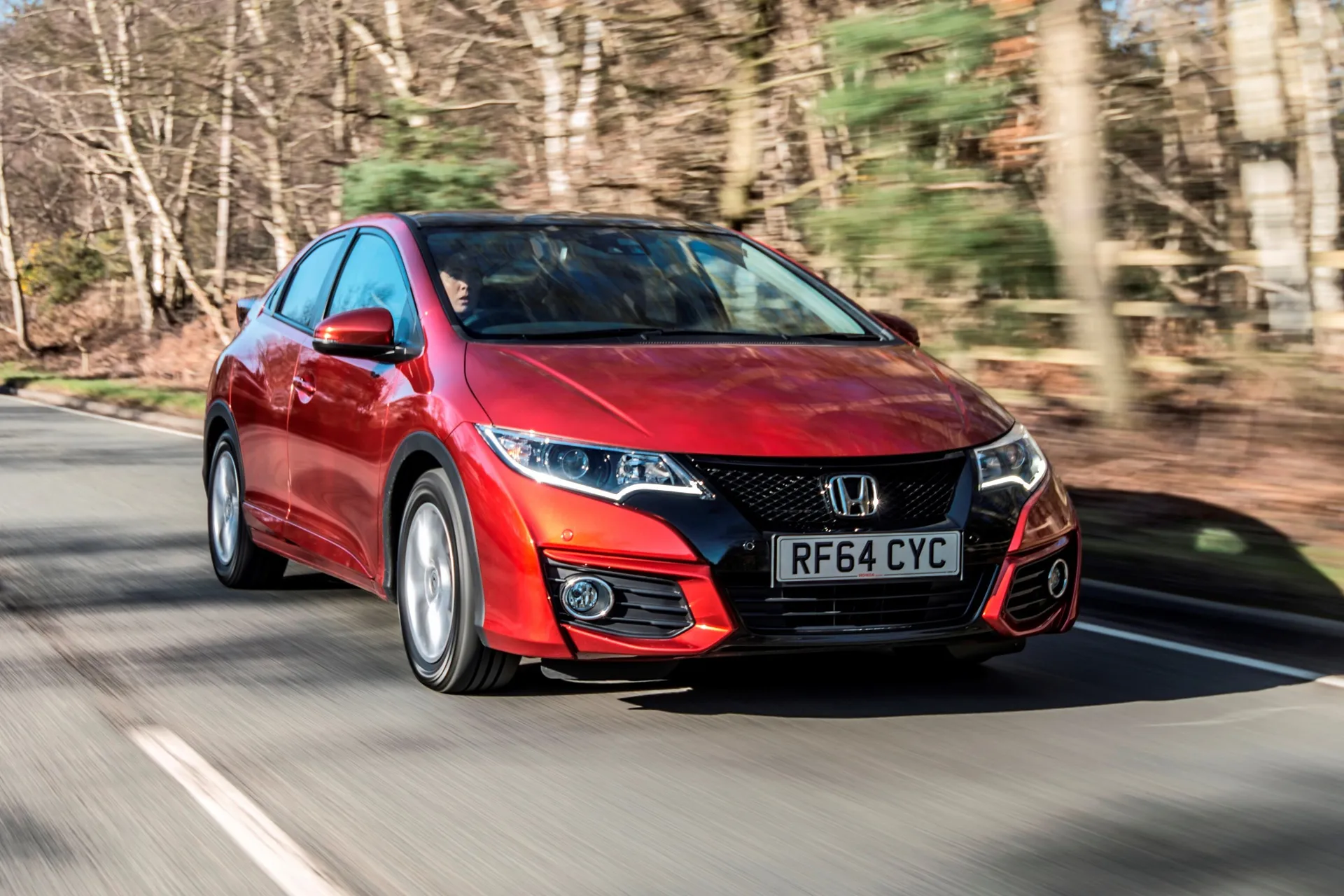
It’s a bit two-dimensional, cornering perfectly competently but not really interacting with the driver. It can also get a bit unsettled over rough roads, as if the suspension is running out of ideas - Honda used a cheaper, less sophisticated type of rear suspension than its class-leading rivals.
The Civic does offer an impressive amount of grip, so you can turn in at faster speeds confident the front end will hold on. But the steering wheel doesn’t deliver the amount of detailed feedback to give you total confidence, sadly.
Ride quality was smoother than the previous Civic, but still not as pliant as a Volkswagen Golf. Again, it was generally settled enough, but more challenging roads can see things degenerate, and variants with larger alloy wheels can feel crashy at times. You’ll also notice the suspension is a bit noisier than in a Golf, feeding through the rattle and clatter of bumps, which also makes it feel less sophisticated.
The best-handling Civic of this era is the Type R – but this is also the one with the most concrete-like ride quality. You pays your money…
What engines and gearboxes are available in a Honda Civic?
Don’t bother with the 1.4-litre petrol engine unless you’re after the cheapest-possible Honda Civic (or, as we’ll see, the cheapest to insure). It’s an engine that’s great in the smaller Honda Jazz, but isn’t big enough to convince in a Civic – as evidenced by a 0-62mph time of over 13 seconds.
The 1.8-litre is much better. Instead of a weak 100PS, it has 142PS, although you have to rev it to fully release this power. That’s a Honda petrol engine characteristic, due to the famous VTEC system, and it contrasts with the lazier, easier drive of turbocharged alternatives. It also means the 1.8 feels a bit ‘revvy’ on the motorway, due to its lower gearing.
The 2.2 diesel is excellent. It is more powerful than the petrols, producing 150PS, and has a beautifully smooth nature. It’s very hushed indeed at cruising speeds. It fell victim to tougher emissions standards, though, and was replaced by a 1.6 i-DTEC diesel. This is a little more clattery, but still very smooth for a diesel, and even the 120PS version offers decent pull. On paper, it looks a fair bit slower than the 2.2, but in everyday use the difference is minimal.
Only the 1.8 petrol is offered with an automatic gearbox option. It’s OK but not brilliant, and not a patch on the superb six-speed manual. Honda makes some of the slickest-shifting gearboxes in the world and the Civic is just one more car to benefit from them.
Refinement and noise levels
The Honda Civic isn’t the most refined car in its sector, but it’s hardly what you’d call loud. There’s a bit more road and wind noise than the best rivals, but it’s still acceptable.
The noisiest aspect with petrol engines is the motors themselves – because you need to rev them a bit more than turbocharged alternatives. Those who are enthusiastic drivers will love this, because Honda’s VTEC engines are charismatic (particularly the 1.8-litre), but for others, it might seem too much like hard work.
The 2.2 diesel is uncommonly smooth and free-spinning. The 1.6 is a bit rougher, but it’s still acceptable, and both settle down into the background on the motorway for easy cruising.
A strange source of noise you might occasionally notice is the slosh of fuel in the tank. Because it’s mounted right below you, a half-full tank can sometimes be audible when you’re chucking the Civic around. It’s not a criticism, just a quirk, and nothing to worry about.
Safety equipment: How safe is the Honda Civic?
A good haul of safety equipment includes front, side and curtain airbags, stability control and seatbelt pre-tensioners. All seats were fitted with seatbelt reminders.
Safety watchdog Euro NCAP duly gave the Honda Civic five stars in 2012, with a strong 94% score for adult occupant protection and 83% for child safety. Pedestrian protection, perhaps due to that short nose, was more average, at 69%. But active safety assist features were strongly praised, with an 86% score.
For 2014, a Driver Assistance Safety Pack was introduced as an option. This brings useful active safety gadgets, including auto city braking, forward-collision warning, a blind-spot monitor and traffic sign recognition.
By 2015, Honda City Brake Active was standard on all Civics. It uses a radar to scan the road ahead and auto-stop if cars or pedestrians are detected and the driver doesn’t respond. It is active at speeds of 18mph or less. Unusually, the Civic doesn’t have a standard speed assistance device, but it does have a cut-off switch for the front passenger airbag.
MPG and fuel costs: What does a Honda Civic cost to run?
"Efficient engines and a jump in aerodynamic efficiency mean good fuel economy across the range, which helps keep fuel costs low."
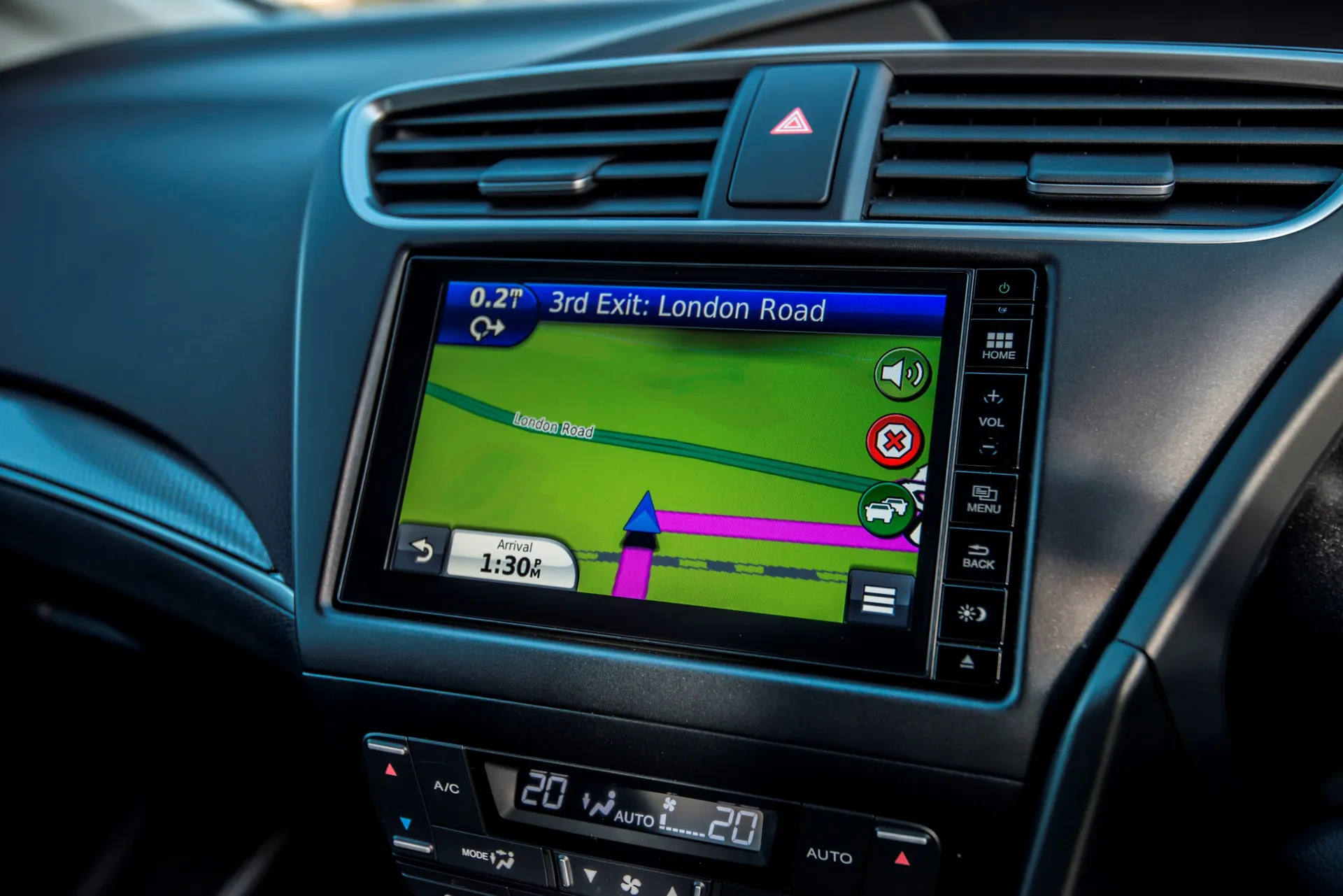
The 1.4-litre petrol engine is particularly good, averaging 52.3mpg, although the price you pay is mediocre performance. We’d rather go for the 1.8-litre and enjoy a still-impressive 48.7mpg.
Diesels are on another level. The 2.2-litre i-DTEC is rated at 67.3mpg and the 1.6-litre i-DTEC is even better, averaging up to 78.5mpg in ultimate ‘Honda Earth Dreams Technology’ guise.
All Civics came with a smooth and speedy stop-start system called Idle-Stop, to boost economy in town. The Civic is also a rare non-hybrid Honda to come with a green ‘Econ’ button, which optimises settings to save fuel. Most owners don’t bother with it, though, as the gains are minimal. It displays two coloured bars either side of the speedo, which change from eco green to non-eco blue depending on your driving style. Some find it useful.
How reliable is a Honda Civic?
The Honda Civic scored a sold 9.25 out of 10 in the HonestJohn.co.uk Satisfaction Survey, which is almost surprisingly low - Honda's have a well-deserved reputation for reliability.
As a brand Honda came 14th out of 30 manufacturers for overall satisfaction, which is solid if unspectacular.
Insurance groups and costs
The entry-level Civic 1.4-litre comes in at a very appealing group eight insurance rating. That’s about as low as it gets for a family-focused five-door like this. Switching from the 1.4 to the 1.8 does see a big jump, though, up to group 16 – it’s unusual for such a hike between engine variants.
The 2.2-litre diesel models are pricier still, starting from group 18 in base S guise. At least the lower power of the 1.6-litre diesel saw a reduction in insurance groups, with them starting from 15. You don’t make any savings from choosing models with all the active safety options fitted, but you won’t pay an insurance penalty for picking a Sport variant either.
VED car tax: What is the annual road tax on a Honda Civic?
Sub-100g/km CO2 emissions for the 1.6-litre diesel mean free road tax (for every single version, even higher-spec models with larger and less efficient alloy wheels). That said, the 2.2 is hardly bank-breaking, with prices from £20 a year. Compared to the old diesel Civic, this saves a small fortune in annual VED.
The 1.4 petrol in its most efficient guise is rated at £125 a year, rising to £150 for models with larger alloys. The 1.8 in manual or automatic forms costs from £150 to £165.
How much should you be paying for a used Honda Civic
"Around £6000 will get you into a ninth-generation Honda Civic. At this level, most cars will be 1.8-litre versions – the 1.4-litre is rarer, and you need to spend a bit more to get a diesel."
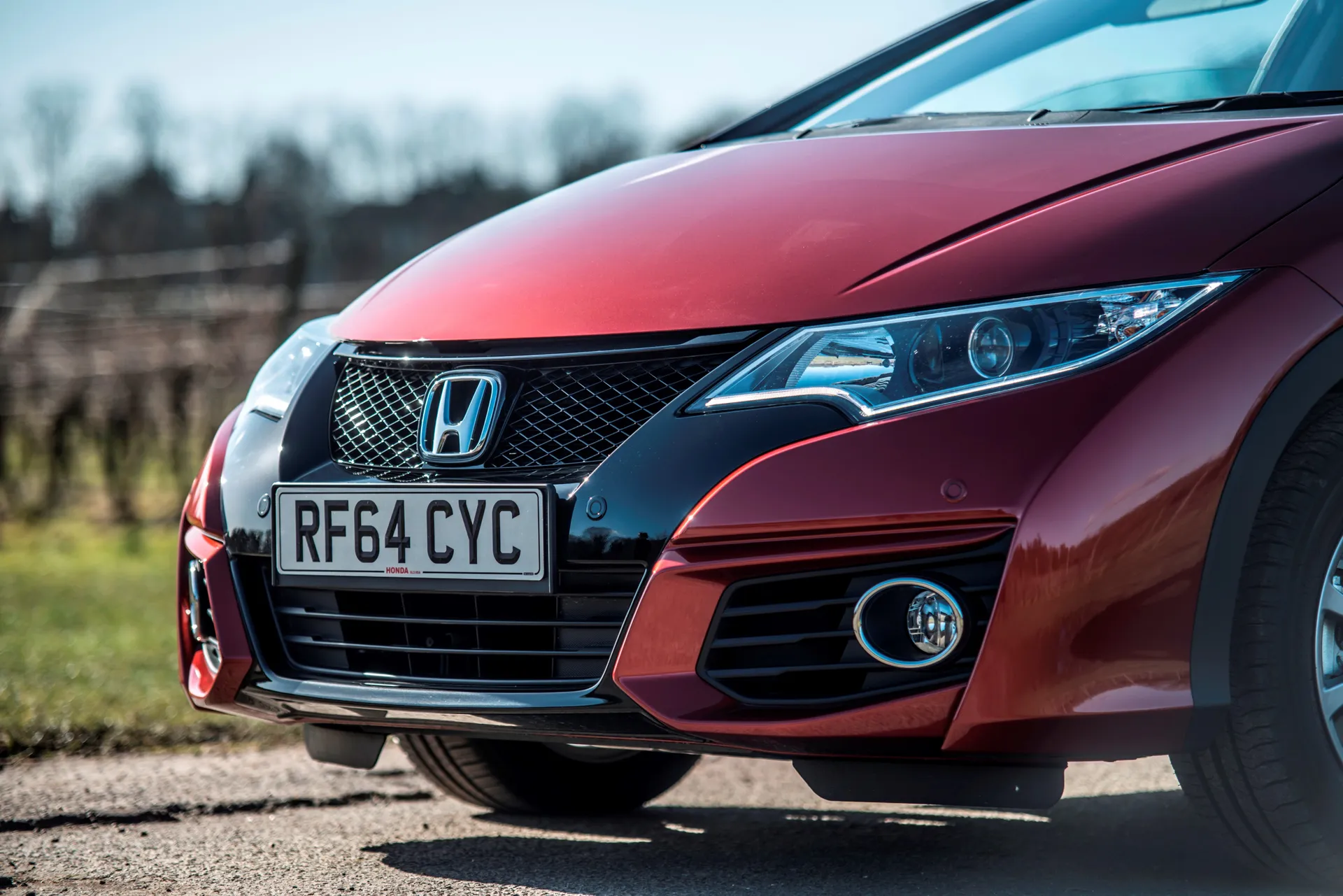
Our tip is to budget for around £7000. This will get you a broad choice of 2014-on 1.6 i-DTEC diesel versions to choose from, including ES and SE trim grades.
Facelifted 2015-on cars are priced from around £8000. You can spot these from their smart LED running lights in the headlights, and slightly neater overall lines. They’re the ones to go for if possible, particularly in fuel-saving 1.6-litre diesel guise. Our pick is Sport trim, with prices currently coming in from just below £10,000.
Trim levels and standard equipment
All Honda Civics come with a good amount of equipment as standard: air conditioning, 16-inch alloys, an alarm, LED running lights, a USB socket and electric door mirrors. Honda Civic ES models add dual-zone climate control, a rear parking camera, Bluetooth, front fog lights, a nice leather steering wheel and fancy aluminium pedals. The Honda Civic EX has heated leather seats, sat-nav and a much-improved premium sound system.
The Honda Civic EX GT is top-spec and has a panoramic glass roof, xenon headlights, bigger 17-inch alloys, all-round parking sensors and an auto-dimming rear-view mirror. Honda Civic SE-T and ES-T grades were optionally available, including sat-nav and touchscreen sat-nav.
It was broadly the same from the 2015 facelift, although all cars now had Honda City Brake Active assist. Wheels grew to 17 inches on SE models, and the newly-introduced Honda Civic Sport grade featured black roof lining, rear privacy glass, black alloy wheels and a colour-coded rear spoiler. Honda Civic SR and EX Plus grades topped the range.
Ask the heycar experts: common questions
Is the Honda Civic a good car?
How much is a Honda Civic in the UK?
Is the Honda Civic expensive?
Get our latest advice, news and offers
Keep me updated by email with the latest advice, news and offers from heycar.
By submitting you agree to our privacy policy
